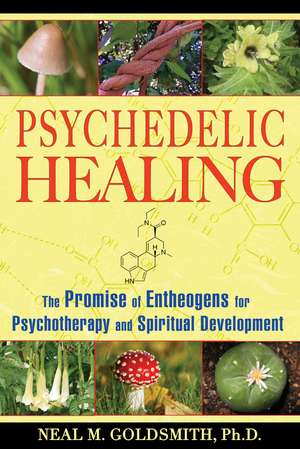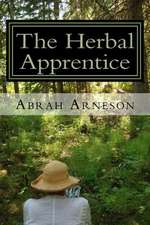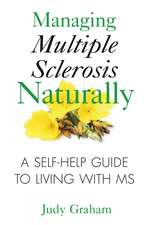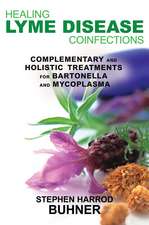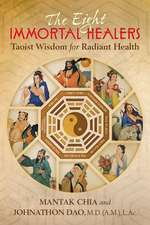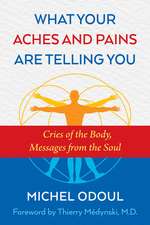Psychedelic Healing: The Promise of Entheogens for Psychotherapy and Spiritual Development
Autor Neal M. Goldsmith Ph.D.en Limba Engleză Paperback – 21 dec 2010
Preț: 75.33 lei
Preț vechi: 101.42 lei
-26% Nou
Puncte Express: 113
Preț estimativ în valută:
14.41€ • 15.09$ • 11.93£
14.41€ • 15.09$ • 11.93£
Carte disponibilă
Livrare economică 21 martie-02 aprilie
Livrare express 01-07 martie pentru 47.28 lei
Preluare comenzi: 021 569.72.76
Specificații
ISBN-13: 9781594772504
ISBN-10: 1594772509
Pagini: 256
Ilustrații: 10 b&w illustrations
Dimensiuni: 152 x 229 x 18 mm
Greutate: 0.27 kg
Editura: Inner Traditions/Bear & Company
Colecția Healing Arts Press
ISBN-10: 1594772509
Pagini: 256
Ilustrații: 10 b&w illustrations
Dimensiuni: 152 x 229 x 18 mm
Greutate: 0.27 kg
Editura: Inner Traditions/Bear & Company
Colecția Healing Arts Press
Notă biografică
Neal M. Goldsmith, Ph.D., is a psychotherapist specializing in psychospiritual development. A frequent speaker on spiritual emergence, drug policy reform, and postmodern society, he lives in New York.
Extras
Chapter 4
The Ten Lessons of Psychedelic Therapy, Rediscovered
Psychedelic plants and derivative compounds and admixtures have been used safely for millennia by indigenous peoples. This tradition of shamanic practices provides the context for the use of psychedelics in psychotherapy and the foundation for our discussion of the methods of psychedelic psychotherapy.
As tribal societies evolved over thousands of years, a set of ritual and community support structures--guidelines of procedure and context--grew up around the use of psychoactive plants, resulting in the first “safety and efficacy” standards. The driving considerations were and are now: 1) how to take these substances in such a way that people have the experience they are looking for and 2) how to do so with the least deleterious effect on the body, mind, and society. The regulatory and policy debates we’re having as a society today may be seen, in part, as an attempt to re-create the controls, guidance, and support that evolved naturally in prehistory.
Over the past fifty-plus years, Western researchers have systematically reinvented the wheel of ancient practice in roughing out the contours of safe and effective psychedelic psychotherapy. The primary clinical “innovations” discovered in the West for the use of psychedelics, such as “set and setting,” turn out to be rediscoveries of methodologies honed through centuries of hard-won tribal trial-and-error experimentation. As such, we must now rethink, embrace, and expand upon the true foundations, not just of Western practice, but of Western research as well.
What follow then, are ten “lessons learned” for psychedelic psychotherapy, along with--in italics--the tribal foundation for each.
1. Setting Can Strongly Influence State of Mind and Thus Outcome
Early researchers sometimes strapped subjects to beds in hospital rooms, under the mistaken view that psychedelics mimic psychosis. Most subjects under these conditions had hellish experiences, thus seeming to confirm the “psychotomimetic” hypothesis. Another, similar term used at that time was “hallucinogen,” which is still used in medical and some scholarly contexts. However, drugs such as LSD rarely produce true hallucinations (e.g., seeing and conversing with a person who is not actually present). Even in institutional settings, enough subjects had beatific experiences that another explanatory term emerged: “psychedelic” or mind manifesting. Over the years, researchers and clinicians have generally come to provide a nonthreatening, physically comfortable, pleasing to the senses, safe, and secure environment, often with specific familial items (such as pictures, dolls, and so forth) or religious content. (The setting must be “safe and secure” not just so there are no outside interruptions but also to assure that a frightened or confused subject or patient cannot bolt the session room.)
Psychedelic subjects can be highly suggestible. Although beatific psychedelic experiences were possible in mental hospitals during the psychotomimetic period, therapeutic peak experiences are more readily attained amid a setting with personally meaningful spiritual music and iconography. Far from problematic, this suggestibility is one of the foundations upon which successful psychedelic psychotherapy must be built.
At the opposite extreme, some healing and psychotherapeutic use of psychedelics has employed carefully designed and controlled intensity as a lever to help patients experience, confront, and resolve their deepest fears and pains.
The tribal context for psychedelic use is inherently safe. Unlike in industrial society, tribal use of psychedelics takes place in a natural context, both environmentally and culturally. When a young person takes a psychedelic in a tribal setting, it is generally in the context of ritual, frequently a rite of passage from one stage of life into the next, and support by family members and other authority figures is the norm. Later, the entire tribal milieu naturally assists in integrating the experience. No sneaking behind the barn to hide drug use here; rather, this is publicly supported use of a sacrament, in a positive and relaxed environment.
At the opposite extreme, many tribal practices have a fearful and intense component to stimulate change during the rite of passage. Yet within the supportive tribal environment, these fearful or painful practices are accepted as healing.
2. Mind-set Can Scuttle a Beautiful Context or Transcend a Hellish One
Open-mindedness and willingness to surrender to the process, confidence in people and surroundings, and motivation to learn and heal rather than to escape or be entertained are all associated with successful outcome.
Mind-set is perhaps the single most important factor in determining the outcome of a psychedelic experience. More influential than setting or dose, “set” trumps all, because set determines the phenomenology or direct internal experience of those other factors.
Even so, it is difficult to discuss mind-set without simultaneously discussing setting. Setting strongly influences the mind-set of the suggestible psychedelic user, and yet mind-set can overcome the influence of even the most powerful religious or family triggers. Another term, used similarly to “set,” is intentionality.” If the deepest, truest intent with which one approaches the experience is sincere and open to whatever learning is encountered, then a positive experience is more likely. On the other hand, if one’s true intent is to avoid certain issues, the stress of that avoidance could cause emotional symptoms that influence the nature and outcome of the psychedelic experience. Of course, such a “negative” experience is also a developmental challenge, the addressing of which brings maturation and a more open intentionality.
The forces that explain the Universe in the animistic worldview are well known by all and driven by spirits that include the plant aides. The plants are seen as active, conscious agents--plant spirits--rather than as things, it is an engagement with the world and with experience that is explicitly reverential.
Tribal participants are completely “ bought into” the concept and practice of using plants for healing and divination and are positive about the benefits to be accrued. Tradition communicates the appropriateness and value of the experience. The tribal worldview fully accommodates the healing action of the ceremonial use of psychoactive plants. Psychedelics increase suggestibility and the sacramental, receptive tribal mind-set is ideal for the effective use of these plants to catalyze spiritual transformation.
Cuprins
Foreword Why This Book Matters by John H. Halpern, M.D., Harvard Medical School
Acknowledgments
Preface
Introduction The Questions That Led to This Book
1 Set and Setting
The Mother of All Trips
Who I Am
How I Became Interested in Consciousness and Psychedelic Therapy
How I Got to Be Who I Am Now
A True Intellectual-Religious Revelation
2 Is Fundamental Personality Change Possible?
The Concept of Change and Its Action
The Developmental Psychology of Spiritual Emergence
Personality Development as Immature Strategy
Psyche: The Core Concept
Psycheology: The Study of the Soul
The Psycheology Approach to Psychotherapy
3 The History of Psychedelic Research
The Major Psychedelics
The First Research on the Clinical Applications of Psychedelics
Psychedelic Research in Countries beyond the U.S.
Psychedelic Research Finally Resumes
The Use of Psychedelics with the Dying
The Safety and Efficacy of Psychedelics
4 The Ten Lessons of Psychedelic Therapy, Rediscovered
Lesson 1. Each Drug Has a Specific Effect
Lesson 2. Setting Can Strongly Influence State of Mind and Thus Outcome
Lesson 3. Mind-set Can Scuttle a Beautiful Context or Transcend a Hellish One
Lesson 4. In General, Dose Determines a Mild or Extreme Experience, Although It Can Be Less Important Than Set and Setting
Lesson 5. Preparation and Knowledge Can Enable Lasting Value
Lesson 6. Ritual Can Transmit Prior Wisdom and Guide Successful Practice
Lesson 7. Support from Experienced Guides Reduces Fear and Increases Benefit
Lesson 8. Reentry in to a Supportive Community Context Aids Retention
Lesson 9. Accompanying Depth Psychotherapy (If Needed) and Ongoing Spiritual Practice Offer the Main Opportunity for Lasting Growth
Lesson 10. A Revised Worldview Is Both a Requirement for and a Result of Integrated Psychedelic Practice
5 Many Thorny Theoretical and Methodological Questions Remain
Why Does Psychedelic Research Require Self-Experimentation?
How Will We Train a New Generation of Psychedelic Researchers and Therapists?
Why Redo Psychedelic Research Already Conducted in the ’50s and ’60s?
How Should Psychedelics Be Rescheduled?
Why Do Psychedelics Provide Pain Relief for the Dying?
Can Psychedelics Provide Lasting Change?
Can Psychedelics Induce Real Spirituality?
6 The Development of an Integral Clinical Approach
Transcendence Vs. the Frontal Assault
Catharsis, or How I Completed My Childhood at Burning Man
A Revised View
Conclusions: What Have We Learned?
7 Implications for the Future
The Catalytic Role of Psychedelics in the Emergence of an Integral Society
Unity “Versus” the Frontal Lobes
An Integral Approach to Reality
Epilogue
Appendix 1 How to Put Science into Action to Change the World
Work to Change the Drug Laws
Changing Psychedelic Policies and Bureaucracies
Practice “Right Action”: Buddhism and Psychedelics Policy
Appendix 2 Standards for Safe and Effective Psychedelic Journeys and Procedures for Handling Psychedelic Emergencies
Preparation: Creating a Safe Space for Psychedelic Journeys
The Session: Guidelines for Safe and Effective Psychedelic Journeys
Dealing with Psychedelic Emergencies (or Spiritual Emergence)
Recommended Reading
Notes
Bibliography
Index
Recenzii
"In terms of both academics and activism, it is the most comprehensive and readable book on this subject that I've come across."
“Psychedelic Healing is full of knowledge and wisdom, psychologically sophisticated, and up-to-date. It contains important lessons for those wishing to work with psychedelic plants and substances, which are powerful and tricky tools for accessing the psyche. Neal Goldsmith makes a well-reasoned plea for society to use them once again because they are important tools for healing inside, healing relationships, and healing society. I enjoyed his speculation about the post-postmodern synthesis of tribal and modern. Written bravely and with open eyes, this is an important, mature book”
“In synchronous timing with the publication of Jung’s precious personal vision, Neal Goldsmith presents his own Red Book of self-discovery and organizes it into a useful road map to the mystery within each of us--of who we are and why . . .”
“Neal Goldsmith is one of the leading architects of the emerging paradigm of psychedelic therapy. In this book he shares the personal story of his own process of growth and transformation as both a drug policy analyst and a psychotherapist and boldly calls for the acceptance and integration of psychedelics into psychiatry and society as the powerful catalysts for self-exploration and healing that they are.”
“Neal Goldsmith’s comprehensive, wise, and timely guide explores the impact of psychedelics throughout history and today at the level of the individual, the society, and the collective consciousness. Psychedelic Healing addresses salient theoretical questions pertinent to policy, therapy, spirituality, and philosophy and offers a bountiful harvest of hardearned insights to every reader interested in the transformative power of psychedelics. Neal has made a major contribution to ensuring the continued expansion of the psychedelic research renaissance. Psychedelic Healing will enable motivated readers to work more effectively to create a world where the mature use of psychedelics for spiritual, psychological, and medical purposes is both accepted and appreciated.”
“In this lively and provocative book, Neal M. Goldsmith, Ph.D., makes the case for a ‘Psychedelic Renaissance,’ one in which LSD-type substances would be rescheduled in the United States, permitting their applications in psychotherapy and medicine. Psychedelic Healing presents considerable evidence from the research and clinical literature, as well as from Goldsmith’s own experiences, that psychedelics can relieve pain, change personality, foster spiritual growth, and promote community harmony. After reading this book, many of his readers will be persuaded that this renaissance cannot come a day too soon!”
“Written with personal warmth and passionate engagement, Psychedelic Healing makes a compelling case for the medical and social benefits of a therapy practice that encompasses substance-induced experiences of transcendence. With scrupulous care, Neal Goldsmith explores the great promise of this reemerging field, while proposing a path forward that avoids the mistakes made a generation ago. This book is valuable reading for those who would like to see a crucial new chapter open in consciousness studies and the mental health field.”
“What a brave and wonderful book! Neal Goldsmith beautifully integrates personal experience and reflections with thoughtful analysis of psychedelics: their history, prohibition and regulation, and potential for transforming our psyches, spirits, and lives.”
“A wonderful blend of psychedelic history. Goldsmith has written a radical, wise, and compassionate rethinking of the nature and purpose of psychotherapy. This is the direction psychology needs to go in order to stay relevant and valuable.”
“A thoroughly researched and engaging discussion of psychedelic-assisted psychotherapy, profiling not just the drugs, but many luminaries in the psychedelic research field. Goldsmith emphasizes the importance of set, setting, and ritual on outcome. By chronicling his own growth and transformation he answers the question, ‘Is fundamental personality change possible?’ with an emphatic ‘Yes!’”
“When we look back at the extraordinary cultural transformations of the past forty years, there is one ingredient in the recipe of social change that is consistently and inexplicably expunged from the record. And that is the fact that countless thousands, indeed millions, of young at some point in their lives lay prostrate before the gates of awe having taken a psychedelic. Neal Goldsmith’s insightful book suggests that perhaps we might do well by doing the same.”
“Neal Goldsmith’s comprehensive analysis of the healing power of psychedelics puts the medical, spiritual, and legal status of these soul medicines in a passionate, well-informed voice.”
“Psychedelic Healing is a comprehensive contextualized guide for harnessing psychedelics to assist in personal evolution. Neal Goldsmith introduces you to all the key players at this exciting moment in the long history of human interaction with psychedelic plants. Goldsmith’s clinical yet revealing and accessible narrative is as reassuring as it is instructional. Not since The Tibetan Book of the Dead has there been such a useful companion to the amazing array of spiritual medicines that are nature’s gift to humanity.”
“Written with authority and scholarship, this book is intended for the therapeutic mental health community and will find readers at any academic institution with a psychology department. However, the wider audience of seekers and free thinkers make this appropriate for most public library collections as well.”
“An analysis that looks deep into history as well as the true medical effects of the drug, Psychedelic Healing is a fascinating analysis into a taboo avenue of medicine.”
“Dr. Goldsmith proposes how psychedelic healing can be incorporated into a new, integrated psychotherapy that harnesses the emotional, mental and spiritual healing powers of these entheogenic gives guidance on safe “tripping” and on handling emergencies. . . This is a visionary approach towards a whole new reality.”
“By calling on insights from personality development, Goldsmith enriches our understanding of how psychedelics can lead to a richer, more mature self and at the same time help people re-identify with the true, inner transcendent self: the path of personal, psychological growth persisted in long enough becomes a path of spiritual growth. Then, using this expertise in a large-scale institutional and social change, he proposes a number of careful steps to beneficially fit psychedelics into society. Thus Psychedelic Healing moves forward both personal maturity and institutional growth for their combined benefits”
“. . . ideal combination of facts, personal experiences and most importantly, hope for the future of psychedelics. Their time has come and Neal tells us why and how to make that happen.”
“Psychedelic Healing offers the reader a wondrous journey, capturing within one volume a guide for the use of psychedelics by therapists and patients as well as a contemporary summation of relevant research and points of history. Goldsmith bravely goes where few dare to tread, especially in his autobiographical vignettes that make clear how what is learned through psychedelic-assisted therapy can usefully be applied and integrated into everyday life. This book is highly recommended to anyone interested in learning how psychedelics may contribute to a healthier, richer, and more rewarding life rather than just assuming that these substances must be categorized as drugs of abuse. There is more to these substances than their pejorative categorizations within a Drug War: Psychedelic Healing offers an easy-to-read path to these deeper waters.”
“Psychedelic Healing is full of knowledge and wisdom, psychologically sophisticated, and up-to-date. It contains important lessons for those wishing to work with psychedelic plants and substances, which are powerful and tricky tools for accessing the psyche. Neal Goldsmith makes a well-reasoned plea for society to use them once again because they are important tools for healing inside, healing relationships, and healing society. I enjoyed his speculation about the post-postmodern synthesis of tribal and modern. Written bravely and with open eyes, this is an important, mature book”
“In synchronous timing with the publication of Jung’s precious personal vision, Neal Goldsmith presents his own Red Book of self-discovery and organizes it into a useful road map to the mystery within each of us--of who we are and why . . .”
“Neal Goldsmith is one of the leading architects of the emerging paradigm of psychedelic therapy. In this book he shares the personal story of his own process of growth and transformation as both a drug policy analyst and a psychotherapist and boldly calls for the acceptance and integration of psychedelics into psychiatry and society as the powerful catalysts for self-exploration and healing that they are.”
“Neal Goldsmith’s comprehensive, wise, and timely guide explores the impact of psychedelics throughout history and today at the level of the individual, the society, and the collective consciousness. Psychedelic Healing addresses salient theoretical questions pertinent to policy, therapy, spirituality, and philosophy and offers a bountiful harvest of hardearned insights to every reader interested in the transformative power of psychedelics. Neal has made a major contribution to ensuring the continued expansion of the psychedelic research renaissance. Psychedelic Healing will enable motivated readers to work more effectively to create a world where the mature use of psychedelics for spiritual, psychological, and medical purposes is both accepted and appreciated.”
“In this lively and provocative book, Neal M. Goldsmith, Ph.D., makes the case for a ‘Psychedelic Renaissance,’ one in which LSD-type substances would be rescheduled in the United States, permitting their applications in psychotherapy and medicine. Psychedelic Healing presents considerable evidence from the research and clinical literature, as well as from Goldsmith’s own experiences, that psychedelics can relieve pain, change personality, foster spiritual growth, and promote community harmony. After reading this book, many of his readers will be persuaded that this renaissance cannot come a day too soon!”
“Written with personal warmth and passionate engagement, Psychedelic Healing makes a compelling case for the medical and social benefits of a therapy practice that encompasses substance-induced experiences of transcendence. With scrupulous care, Neal Goldsmith explores the great promise of this reemerging field, while proposing a path forward that avoids the mistakes made a generation ago. This book is valuable reading for those who would like to see a crucial new chapter open in consciousness studies and the mental health field.”
“What a brave and wonderful book! Neal Goldsmith beautifully integrates personal experience and reflections with thoughtful analysis of psychedelics: their history, prohibition and regulation, and potential for transforming our psyches, spirits, and lives.”
“A wonderful blend of psychedelic history. Goldsmith has written a radical, wise, and compassionate rethinking of the nature and purpose of psychotherapy. This is the direction psychology needs to go in order to stay relevant and valuable.”
“A thoroughly researched and engaging discussion of psychedelic-assisted psychotherapy, profiling not just the drugs, but many luminaries in the psychedelic research field. Goldsmith emphasizes the importance of set, setting, and ritual on outcome. By chronicling his own growth and transformation he answers the question, ‘Is fundamental personality change possible?’ with an emphatic ‘Yes!’”
“When we look back at the extraordinary cultural transformations of the past forty years, there is one ingredient in the recipe of social change that is consistently and inexplicably expunged from the record. And that is the fact that countless thousands, indeed millions, of young at some point in their lives lay prostrate before the gates of awe having taken a psychedelic. Neal Goldsmith’s insightful book suggests that perhaps we might do well by doing the same.”
“Neal Goldsmith’s comprehensive analysis of the healing power of psychedelics puts the medical, spiritual, and legal status of these soul medicines in a passionate, well-informed voice.”
“Psychedelic Healing is a comprehensive contextualized guide for harnessing psychedelics to assist in personal evolution. Neal Goldsmith introduces you to all the key players at this exciting moment in the long history of human interaction with psychedelic plants. Goldsmith’s clinical yet revealing and accessible narrative is as reassuring as it is instructional. Not since The Tibetan Book of the Dead has there been such a useful companion to the amazing array of spiritual medicines that are nature’s gift to humanity.”
“Written with authority and scholarship, this book is intended for the therapeutic mental health community and will find readers at any academic institution with a psychology department. However, the wider audience of seekers and free thinkers make this appropriate for most public library collections as well.”
“An analysis that looks deep into history as well as the true medical effects of the drug, Psychedelic Healing is a fascinating analysis into a taboo avenue of medicine.”
“Dr. Goldsmith proposes how psychedelic healing can be incorporated into a new, integrated psychotherapy that harnesses the emotional, mental and spiritual healing powers of these entheogenic gives guidance on safe “tripping” and on handling emergencies. . . This is a visionary approach towards a whole new reality.”
“By calling on insights from personality development, Goldsmith enriches our understanding of how psychedelics can lead to a richer, more mature self and at the same time help people re-identify with the true, inner transcendent self: the path of personal, psychological growth persisted in long enough becomes a path of spiritual growth. Then, using this expertise in a large-scale institutional and social change, he proposes a number of careful steps to beneficially fit psychedelics into society. Thus Psychedelic Healing moves forward both personal maturity and institutional growth for their combined benefits”
“. . . ideal combination of facts, personal experiences and most importantly, hope for the future of psychedelics. Their time has come and Neal tells us why and how to make that happen.”
“Psychedelic Healing offers the reader a wondrous journey, capturing within one volume a guide for the use of psychedelics by therapists and patients as well as a contemporary summation of relevant research and points of history. Goldsmith bravely goes where few dare to tread, especially in his autobiographical vignettes that make clear how what is learned through psychedelic-assisted therapy can usefully be applied and integrated into everyday life. This book is highly recommended to anyone interested in learning how psychedelics may contribute to a healthier, richer, and more rewarding life rather than just assuming that these substances must be categorized as drugs of abuse. There is more to these substances than their pejorative categorizations within a Drug War: Psychedelic Healing offers an easy-to-read path to these deeper waters.”
Descriere
Psychedelics as therapeutic catalysts for emotional and spiritual transformation.
